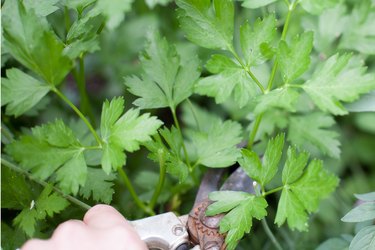
A kitchen favorite, parsley (Petroselinum crispum) is a biennial that's winter-hardy in U.S. Department of Agriculture plant hardiness zones 5 through 9, though it is usually grown as an annual. The best methods to grow parsley from cuttings vary depending on whether you're using leafy stems or root scraps. Flat-leafed or Italian parsley (Petroselinum crispum var. neapolitanum) has a stronger flavor than curly-leafed parsley (Petroselinum crispum var. crispum), which is often used as a garnish. While these two varieties are used for their leaves, Hamburg (Petroselinum crispum var. tuberosum) is grown primarily for its roots.
How to Grow Parsley
Video of the Day
Parley prefers cooler temperatures, so plan to sow your seeds in late winter or early spring if starting indoors. Transplant outside or sow seeds in the garden when the soil temperature is at least 50 degrees Fahrenheit and air temperatures rise to 60 to 65 degrees. In warm climates, you can plant parsley in fall for a winter garden or early winter to late spring for a summer garden.
Video of the Day
Choose a well-draining, sunny or partial-shade location in the garden and dig in 2 to 4 inches of compost. Alternatively, fill flower pots with a loose, rich potting mix to make a container garden. Soak the seeds overnight in warm water before sowing 1/4 inch deep and 6 to 8 inches apart. Water regularly to keep the soil evenly moist until the seeds germinate in five to six weeks.
Continue to water regularly; don't let the soil dry out. Mulch around the plants to slow evaporation from the soil. Fertilize two to three times during the growing season with seaweed extracts or compost tea or by side-dressing with compost.
Grow Parsley From Cuttings
Like many herbs, all three types of parsley can be started from cuttings, even from precut bundles purchased in a grocery store. Use sterilized scissors to take a 3- to 5-inch-long cutting just below a leaf node. Remove the leaves from the bottom two-thirds of the stem. Put the stem in warm water in a jar or insert it into moist sand, perlite or a combination of equal parts perlite and peat moss, making sure at least one node is beneath the water or growing medium.
Hamburg parsley can also be started from kitchen scraps. When cutting up the root, leave 1/2 to 1 inch of the top and an equal amount of the foliage. Place the cut side down in 1/2 to 1 inch of water or plant in moist sand or potting soil.
Place the parsley cutting in a brightly lit, sunny window. Change the water every few days, or if you are growing it in soil, keep the mix evenly moist as the plant grows new roots and foliage. Harvest the new leaves as needed for cooking. Hamburg leaves are on the bitter side and are stronger flavored than the other parsley varieties, so you might want to transplant the cutting outside to nourish black swallowtail and other caterpillars rather than using it in your food.
Harvest and Store Parsley
Harvest your parsley by gathering a bunch and snipping the stems with a sharp knife or scissors. Always sterilize your cutting tools when working with plants by wiping the blades with rubbing alcohol.
Rinse the leaves and place them with the stems in a glass or jar of water. Refrigerate until you're ready to use the parsley. Alternatively, hang the washed parsley bunches to dry in a warm location and then remove the dried leaves and store them in an opaque, airtight container. In general, the leaves of Italian and curly-leafed parsley are better for drying and storage than Hamburg.
To harvest Hamburg, pull the roots from the soil just like any other root vegetable, rinse thoroughly and enjoy it raw or cooked. The roots are sweeter if you can wait until after the first few frosts in fall but don't let it flower and go to seed. Harvest parsley roots in their first year; if you let them grow into the second season, they can become tough and bitter. Parsley root can be chopped and used in soups and stews or can be roasted or sautéed.